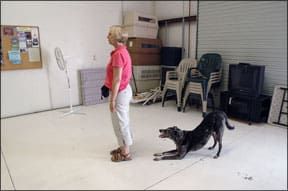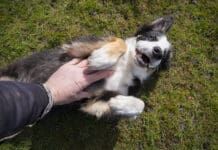Students in my Level 2 class are learning the “stay” dog behavior. Some of the pupils are doing great with the concept of “stay in the position I left you in until I tell you to change positions,” but one Border Collie isn’t having much success.
Charlie willingly sits on cue, but when clicks and treats don’t come fast enough, he starts trying other canine behaviors in his repertoire – with rapid-fire offerings of shake, speak, down, and even a roll-over finding its way into the mix. He gets so excited about the training game that sometimes he doesn’t even bother to sit first when asked, but drops right into the down – his favorite position. Charlie, an eager worker who loves positive dog trainging reinforcement, has learned a lot of different behaviors and is anticipating his human’s cues for all his favorite tricks. He clearly doesn’t have his behaviors under stimulus control.
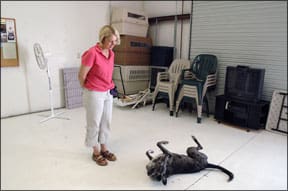
288
Stimulus control means your dog offers a specific canine behavior when you ask for it and doesn’t offer it if you haven’t asked for it. In reality, the only dogs on earth under total stimulus control all the time are robotic dogs, not living, breathing beings. At best, very well-trained dogs (through positive dog training methods) achieve that level of behavior when they are actively working. Otherwise, your very well-trained dog could never sit or lie down of his own volition, even when he was “off-duty.”
Before I explain how to get your dog to do what you want him to do, when you want him to do it, allow me to define some terms, and discuss the difference between a positive training approach – like I teach and Whole Dog Journal advocates — and a training program that uses aversive techniques.
Positive approach
A stimulus is something that causes a behavioral response. Some stimuli result in a response without training. Things like lights, sounds, scents, and things that cause physical discomfort (heat, cold, pain) are called primary or unconditioned stimuli. You don’t have to teach your dog to contract the pupils of his eyes if you shine a bright light in them – it just happens. He’s likely to jump when he’s startled by the clang of a stainless steel dog bowl dropping on the kitchen floor, and drift closer to the kitchen when you bake Italian meatballs, even if he’s never experienced those stimuli before.
A “secondary stimulus” is a signal that is meaningless to the dog until it is associated with a behavior that is then reinforced. The signal word “sit” means nothing to your dog until you help him connect it to the act of putting his bottom firmly on the floor, and until the sequence of “sit = bottom on floor” is repeatedly reinforced. With training, the initially meaningless “sit” sound becomes the cue for the desired behavior of putting bottom on floor.
In positive training, we first get the dog to do the behavior, then add the cue (secondary stimulus). We have a variety of techniques at our disposal to get the dog to do the behavior. We can “capture” the behavior – observing the dog, waiting until he does a certain behavior, and then “marking” it (with the click of a clicker or word such as “Yes!”) and rewarding him for it. Or we can “lure” the behavior, by using a food or toy that your dog moves toward, to get him to move into a certain position or perform a certain movement (which can then be marked and rewarded). Or we can “shape” the behavior, by marking and rewarding your dog for successively more “correct” approximations of the movement or behavior you want.
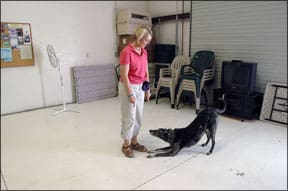
288
When we can reliably get your dog to do the behavior, we start adding the cue just before he does the behavior. This creates the sequence of “Sit!” = bottom on floor = treat happens (positive reinforcement).
The old-fashioned way of giving meaning to the word “Sit!” was to give the “command” first and then pull up and/or push down on the dog to get the desired behavior. The reinforcement in that case was negative; the sit behavior made the pushing and/or pulling go away. This also created the necessary sequence of “Sit!” = bottom on floor = bad stuff goes away (negative reinforcement). This old-fashioned way works, but positive trainers don’t use it; our preference is to help our dogs learn how to solve training problems and offer behaviors, rather than physically manipulating or forcing them into position.
Charlie the Border Collie understands that “Sit!” means to put his bottom on the floor – some of the time. He’s made the association, but doesn’t yet understand that it means “always and only.” Lack of stimulus control is a common occurrence in positive training. When we are good at reinforcing dogs for offering behaviors, dogs get really good at offering them. Plus, teaching new behaviors is often more fun and exciting – and more reinforcing for the dog, since we tend to use more treats and praise when a dog is learning a new behavior. In the beginning, we often reward successive approximations of a new behavior at a high rate of reinforcement . . . and the rewards may slow as we become more selective about what we choose to reinforce, in an attempt to “shape” the behavior and indicate to our dog which approximation of the behavior is the one we want.
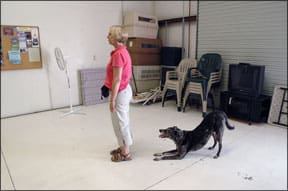
288
We also deliberately slow our treat frequency to a variable pattern of random reinforcement when we put a behavior on an intermittent schedule of reinforcement to help the dog learn to keep working even if he doesn’t get a click and treat every time. This is done when a dog has become reliable at performing a given behavior – that is, he’ll do it at least 8 out of 10 times when you ask him to. A lack of stimulus control may be a common “side effect” among dogs and owners who use positive methods, but it’s (in our opinion) preferable to the most common side effects of coercive training methods.
Dogs trained by old-fashioned coercion usually learn that the safest thing to do, unless expressly asked, is nothing. Force-based trainers attain stimulus control with a choke chain, immediately squelching any unasked-for behavior with a sharp collar “correction” – a jerk on the leash. Of course, dogs trained with this method often become very reluctant to offer unasked-for behaviors, so valuable training techniques such as shaping, and a certain degree of trust, go out the window. (See “Fun Training Techniques for You and Your Canine!,” March 2006.)
Steps to stimulus control
The first step, getting your dog to offer the behavior on cue, is really the easiest part. Using capturing, luring, and/or shaping, you can elicit and reinforce pretty much any canine behavior you can conceive of, and then add the cue.
Now comes the more difficult part: not reinforcing behaviors that our dogs offer spontaneously. But if you want stimulus control, you’ll have to be consistent in this.
Of course, you can choose your venues. You can (and should!) still reinforce spontaneously offered default sits outside of your formal training session, especially if you’ve encouraged your dog to offer them – such as in a “Say please” program, where you teach your dog that the very polite and spontaneously offered deference behavior of “sit” makes good things (treats, praise, and other rewards) happen. But when you are specifically focused on training – if you want stimulus control – you’ll need to be very clear with your signals, reward markers (clicks), and reinforcement. So here’s the plan:
-Figure out how to elicit the behavior so you can reinforce it.
-When you can elicit/predict a behavior consistently at least 8 out of 10 times, you can add the cue just prior to the behavior, and begin fading (diminishing) prompts and lures – treats and body language that help the dog understand what the cue means. During this phase you may need to cue, pause, then prompt or lure, to help your dog transfer his association with the behavior from the lure to the cue. These first steps are the acquisition stage of learning; the dog is just figuring out how to do the behavior you’re asking for.
-When the cue will elicit the behavior at least 8 out of 10 times without a prompt or lure, you’re ready to tighten up your stimulus control; you will no longer click and reward the behavior (sit) if you haven’t asked for it, nor will you click and reward your dog if he offers a different behavior (down) when you ask for sit, even if you’ve been working really hard to get him to offer downs. Work on downs in a different section of your training session to avoid confusion, or in an entirely different session. This is “fluency”; the dog performs the behavior easily, on cue.
-If your dog offers an unsolicited behavior that is different from the one you are working on, or anticipates your cue for the one you are working on, remove all reinforcement. You want to extinguish unsolicited behaviors (cause them to go away). You may choose to use a neutral-voiced “no reward marker” (NRM) such as “Oops!” or “Time out!” or “Sorry!” as you turn away to remove your attention, or just turn away without a marker. Wait several seconds, and then resume training. Give your cue for the sit again.
-If several short time-outs in succession don’t seem to have an impact – if your dog keeps offering the wrong behavior – try a few longer time-outs, like a minute or two, where you actually go away and sit down before you resume training. If you are consistent about removing reinforcement, you should eventually extinguish spontaneous offerings.
Performance anticipation
Some dogs seem to share the same joy we do in practicing a wide variety of behaviors, as if the cue to perform one is an invitation to show off the entire repertoire. This can be frustrating when you’re doing an “onstage” performance for your friends and family, your son’s class at school, or the residents of the local assisted living facility where you do pet-assisted therapy. You ask your dog to “sit” and, lacking some of the critical elements of stimulus control, he’s halfway through his entire trick routine before you’ve even given him the cue to roll over.
A quick fix for this problem – while you work on stimulus control – is to teach him a solid “wait” behavior (easier than stimulus control), and then use your wait cue following each trick (see “Training Your Dog to Stay Using Cues, May 2001). Your performance might go something like this:
“Skippy, sit!” Click/treat. “Wait!”
“Skippy, shake!” Click/treat. “Wait!”
“Skippy, roll over!” Click/treat. “Wait!”
And so on.
Critical skill?
So, how important is stimulus control, really? Perhaps not very important, if you enjoy your dog as a companion mostly at home and don’t care if he offers random behaviors in the privacy of your own living room. It is probably more important to you if you like to take your dog out in public and want to be sure he will do as you ask in polite company. And it is very important if you have any plans or dreams of competing in any of the doggie sports that require precision in performance, such as rally, obedience, and freestyle.
It may be challenging to establish stimulus control. It’s worth it, however, if you want to wow your friends (and judges) with your dog’s training, and reap the rewards of the increased level of communication this builds between you and your canine companion.
The good news is that dogs seem to be able to generalize the concept of stimulus control; once you’ve established it with three or four behaviors, it tends to get easier and easier as you put more behaviors under stimulus control. Your dog comes to realize that each signal means a different behavior, and that being reinforced depends on recognizing the signal and giving the correct response. It’s good to know that your training will get easier as you go along!
Next month, I’ll discuss other ways you can make your dog’s performance more consistent and reliable.
Pat Miller, CPDT, is Whole Dog Journal’s Training Editor. Miller lives in Hagerstown, Maryland, site of her Peaceable Paws training center, with her husband Paul. Pat is also the author of The Power of Positive Dog Training and Positive Perspectives: Love Your Dog, Train Your Dog.
Thanks to trainer Sarah Richardson, of Chico, California, for demonstrating techniques for the photos in this article.


